冀教版八年级上册Unit 6 Go With Transportation !Lesson 32 Trains Go Faster !课件(共21张PPT)
文档属性
| 名称 | 冀教版八年级上册Unit 6 Go With Transportation !Lesson 32 Trains Go Faster !课件(共21张PPT) |  | |
| 格式 | ppt | ||
| 文件大小 | 5.7MB | ||
| 资源类型 | 教案 | ||
| 版本资源 | 冀教版 | ||
| 科目 | 英语 | ||
| 更新时间 | 2022-06-02 11:25:52 | ||
图片预览

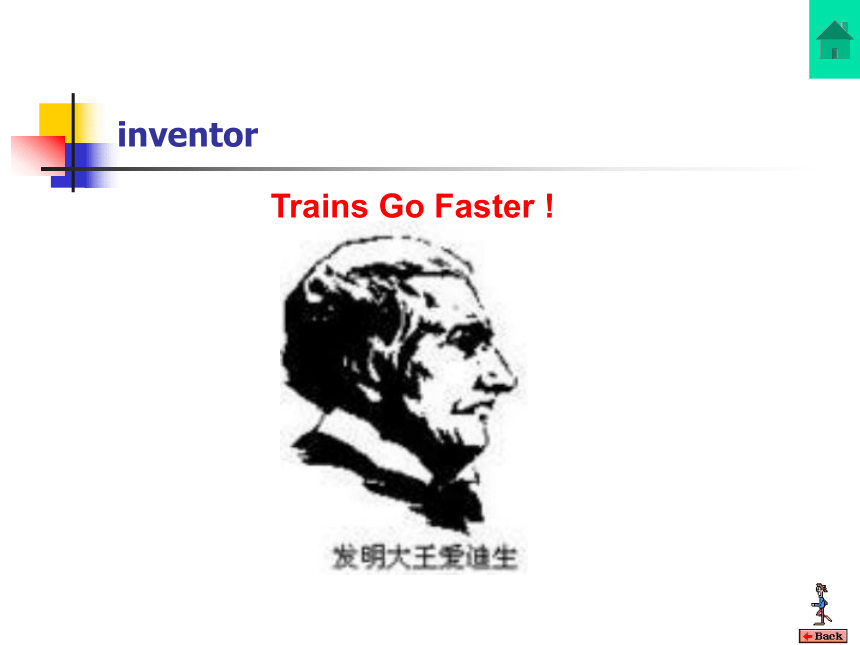

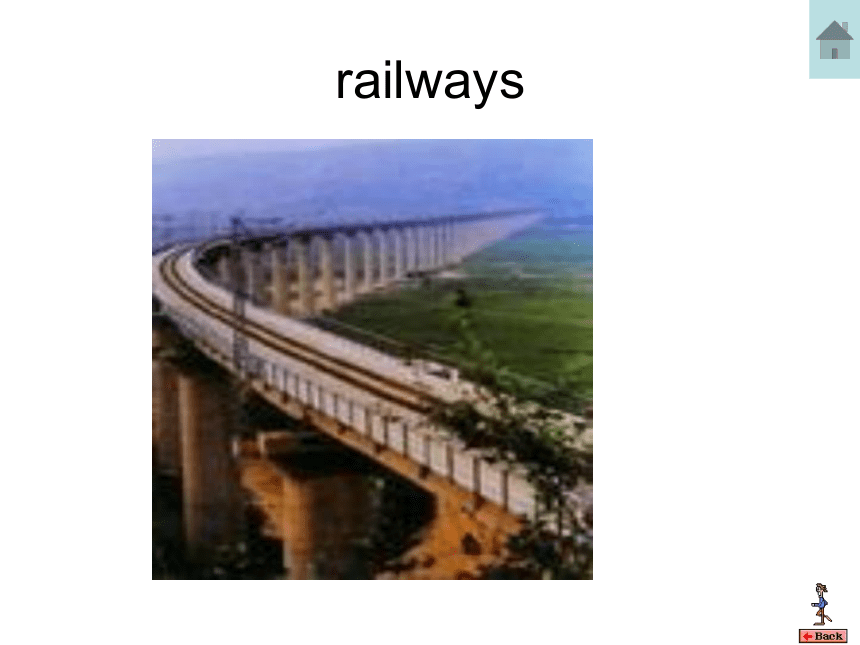
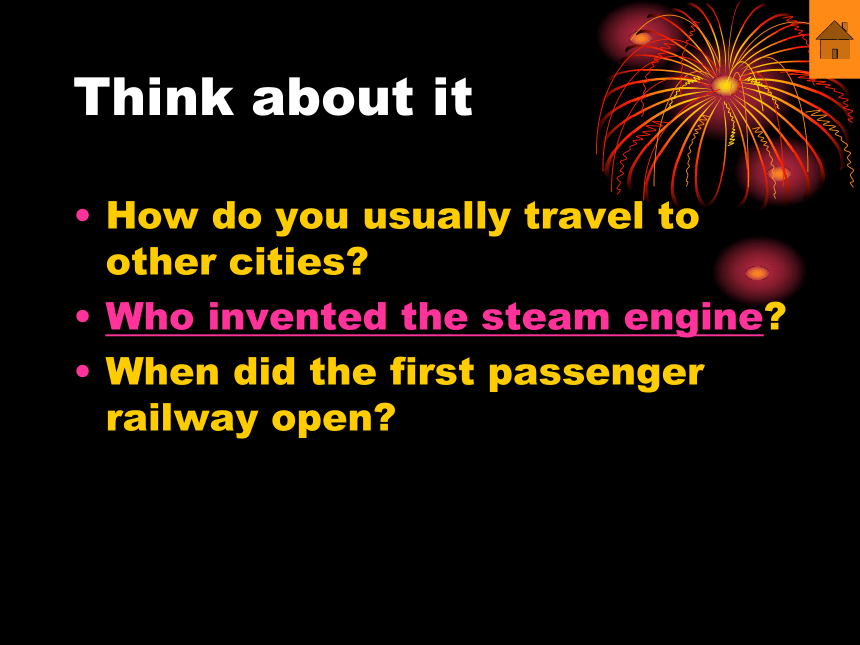
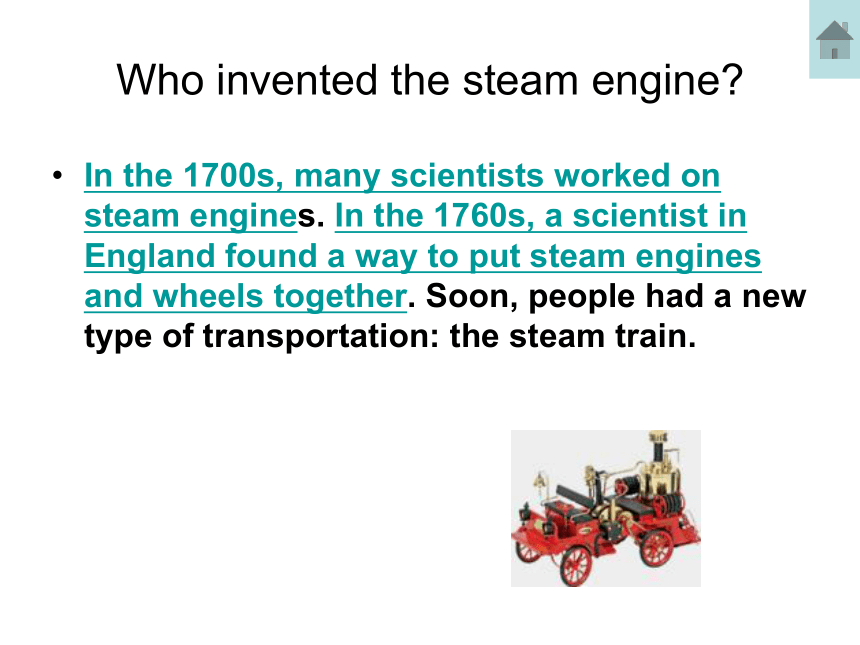
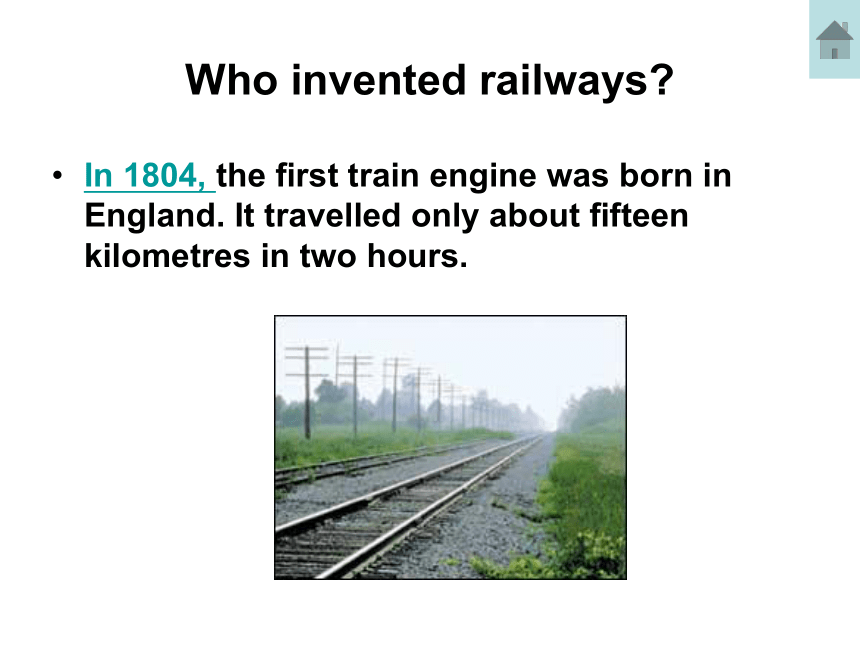
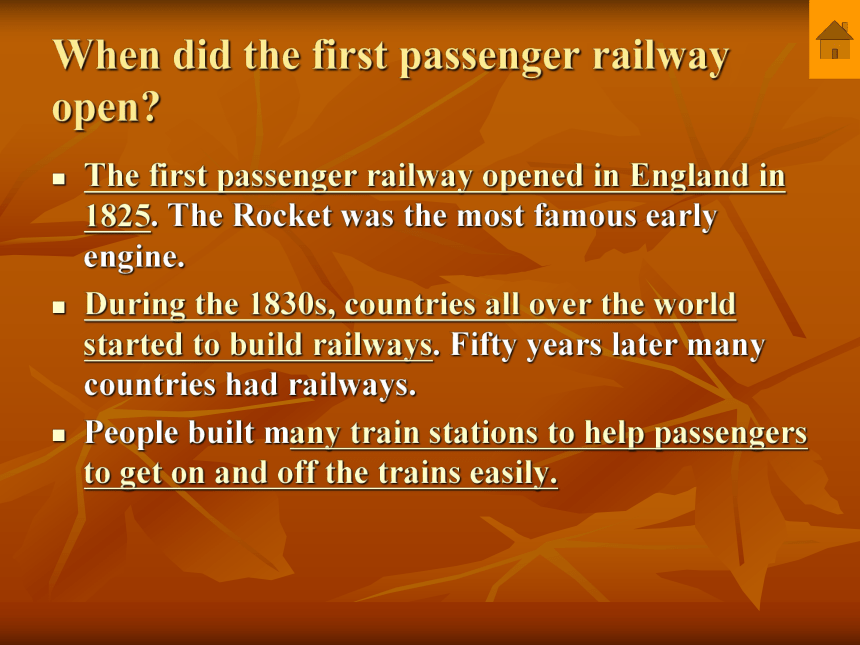
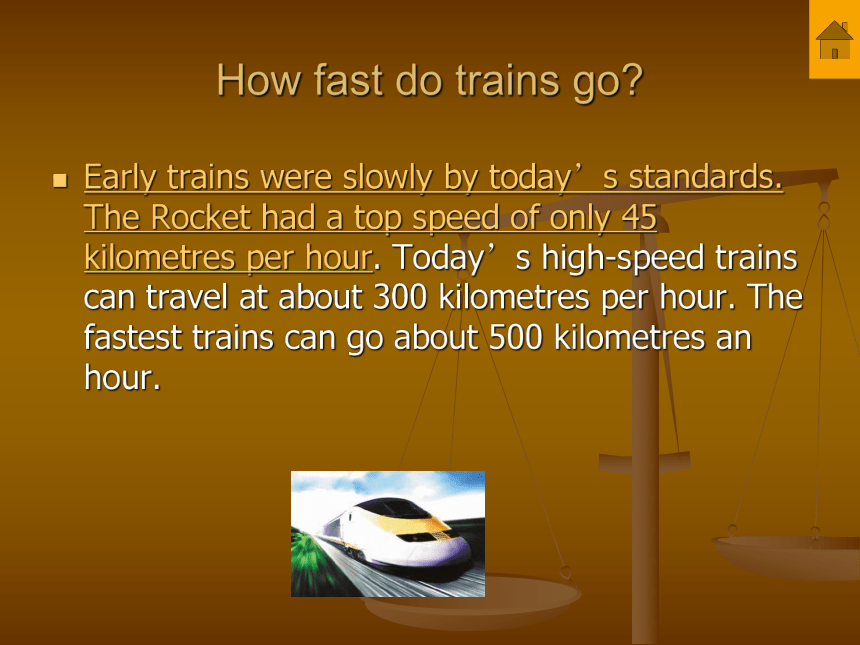
文档简介
(共21张PPT)
Lesson 32
Trains Go Faster !
new words
think about it
text
inventor
Trains Go Faster !
wheel
railways
Think about it
How do you usually travel to other cities
Who invented the steam engine
When did the first passenger railway open
Who invented the steam engine
In the 1700s, many scientists worked on steam engines. In the 1760s, a scientist in England found a way to put steam engines and wheels together. Soon, people had a new type of transportation: the steam train.
Who invented railways
In 1804, the first train engine was born in England. It travelled only about fifteen kilometres in two hours.
When did the first passenger railway open
The first passenger railway opened in England in 1825. The Rocket was the most famous early engine.
During the 1830s, countries all over the world started to build railways. Fifty years later many countries had railways.
People built many train stations to help passengers to get on and off the trains easily.
How fast do trains go
Early trains were slowly by today’s standards. The Rocket had a top speed of only 45 kilometres per hour. Today’s high-speed trains can travel at about 300 kilometres per hour. The fastest trains can go about 500 kilometres an hour.
How fast this train is!
Who invented the steam engine 谁发明了蒸汽发动机?
invent vt. 发明
Who first invented the airplane 谁最先发明了飞机?
【衔接】
invention n. 发明
How many inventions did Edison have in his life 爱迪生一生中有多少项发明?
inventor n. 发明家
He has invented many things. He is a great inventor. 他发明了许多东西。他是个伟大的发明家。
In the 1700s, many scientists worked on the steam engines. 在18世纪,许多科学家一直致力于蒸汽发动机。
work on致力于,从事于。同义词组是work at。如:
He is working on a new book. 他正在研究一本新著作。
【拓展】
work的用法
1) vt. 工作,干活
Henry works in a factory. 亨利在一家工厂干活。
2) vi. 运转,转动
The watch doesn’t work. 这只表不走了(坏了)。
How does this machine work 这台机器运转得怎样?
3) vi. 起作用,产生影响
Did the medicine 药物起作用了吗?
4) vt. 开动,管理
work a machine开机器 work a farm办农场
5) vt. 使工作,使干活
She worked herself too hard. 她使自己工作得太过度了。
6) work out算出,计算
work out a math problem算出一道数学题
7) work用作名词是不可数名词,其同义词是job是可数名词
Bring your work home. 把你要做的事带回家。
He found a job as a teacher. 他找到了一份教学的工作。
8) at work在工作,表示状态
He’s always at work in the afternoons. 他总是在下午工作。
In the 1760s, a scientist in England found a way to put steam engines and wheels together. 在18世纪60年代,一位英国的科学家发明了把蒸汽机车与车轮结合在一起的方法。
1) in the 年代s, 表示“在几世纪几年代”
如:in the 1730s, 18世纪30年代。
2) a way to do sth. 干……的方法,等于a way of doing sth. 。如:Quick is another way to say fast. 或者: Quick is another way of saying fast. Quick是fast的另外一种表达法。
3) together adv. 一起
They walked down the stairs together. 他们一起走下楼梯。
【拓展】
有关together的短语: get together聚会, together with“连同一起,和……一道”, put…together把……放在/凑在一起
It travelled only about fifteen kilometres in two hours.
about在句中作“大约”讲。如:
There are about sixty students in our class. 我们班里大约有60名学生。
【拓展】
about除了作“大约”讲以外,还有:
1) adv. 到处,在附近,在四周
Is there anybody about 附近有人吗?
The boys are running about. 孩子们跑来跑去。
2) prep. 关于
What have you been thinking about 你一直在考虑什么?
3) be about to do something即将做某事
The plane is about to start. 飞机就要起飞了。
We are about to leave.我们就要离开了。
4) what about…等同于how about…译为“……怎么样?……好不好?”
What about/How about a cup of tea 喝杯茶怎么样?
What about /How about going out for a walk 出去散步怎么样?
During the 1830s, countries all over the world started to build railways. 在19世纪30年代,世界各地的许多国家开始建造铁路。
1) all over…遍及……在整个……,构成的短语常在句中作后置定语或状语。
all over the world全世界 all over China全中国
People all over America like hamburgers very much. 全美国的人都非常喜欢汉堡包。(作后置定语)
We have friends all over the world. 我们的朋友遍天下。(作状语)
2) start to do sth. 开始干某事,等于start doing sth. 例如:
The children started to sing (singing). 孩子们唱起歌来。
【注意】
begin和start均可接不定式和动词的ing形式,但在下列三种情况下后跟to do较好。
a. 主语是物而不是人时。如:
The ice began/started to melt. 冰开始融化。
b. 本身为-ing形式。如:
He is just beginning/started to sleep. 他刚刚开始入睡。
c. 其后的动词与想法、感情有关时。如:
I began / started to understand it. 我开始明白这件事了。
People built many train stations to help passengers to get on and off the trains easily.
为了方便乘客上车和下车,人们建立了许多火车站。
get on 上车,反义词get off下车。
辨析:get on, get in, get off与get out off
1) get on上车,指上火车,大公共汽车、船、飞机或骑马;
2) get in上车,指上出租车。如:
They are getting on the train. 他们正在上火车。
A woman is getting in a taxi. 一位妇女正在上出租车。
3) get off下车,指从火车,汽车、船、飞机或马上下来;
4) get out of下车,指从出租车或小汽车上下来。例如:
Mr. Black has got off the plane. 布莱克先生已经下了飞机。
He is getting out of the car. 他正从小汽车里出来。
The Rocket had a top speed of only 45 kilometres per hour. 火箭的速度仅每小时50公里。
1) a top speed of全速=a full speed of如:
He is driving at a top/full speed of 80 kilometres per hour. 他以每小时80公里的高速驾驶。
at a speed of 以……的速度。如:
at a speed of 50 kilometres per hour以每小时50公里的速度
2) per prep. 每, 如 per hour每小时,per people每人, per day每日,per year每年
Today’s high-speed trains can travel at about 300 kilometres per hour.
现在的快车每小时大约行驶300公里。
at about 300 kilometres an hour 以每小时大约300公里的速度。at一词的用法主要有:
1)(表示某一地点、位置、场合)在……
I met him at the door. 我在门口碰见他。
He stood at the corner of the street. 他站在街道的拐角处。
2) 在时刻
They will meet at three o’clock. 他们将在3点种集合。
3) 与动词连用)向,对。如:look at(看) laugh at(嘲笑) shoot at(朝射击)
Let me have a look at your dictionary. 让我看一看你的词典。
【拓展】
与at有关的短语
at all一点儿也不 at first最初 at home在家 at last最后 at once立刻 at school在学校
at the same time同时 at work在工作 at the end of在……的末尾 at the foot of在……脚下 at the age of在……年龄的时候
Lesson 32
Trains Go Faster !
new words
think about it
text
inventor
Trains Go Faster !
wheel
railways
Think about it
How do you usually travel to other cities
Who invented the steam engine
When did the first passenger railway open
Who invented the steam engine
In the 1700s, many scientists worked on steam engines. In the 1760s, a scientist in England found a way to put steam engines and wheels together. Soon, people had a new type of transportation: the steam train.
Who invented railways
In 1804, the first train engine was born in England. It travelled only about fifteen kilometres in two hours.
When did the first passenger railway open
The first passenger railway opened in England in 1825. The Rocket was the most famous early engine.
During the 1830s, countries all over the world started to build railways. Fifty years later many countries had railways.
People built many train stations to help passengers to get on and off the trains easily.
How fast do trains go
Early trains were slowly by today’s standards. The Rocket had a top speed of only 45 kilometres per hour. Today’s high-speed trains can travel at about 300 kilometres per hour. The fastest trains can go about 500 kilometres an hour.
How fast this train is!
Who invented the steam engine 谁发明了蒸汽发动机?
invent vt. 发明
Who first invented the airplane 谁最先发明了飞机?
【衔接】
invention n. 发明
How many inventions did Edison have in his life 爱迪生一生中有多少项发明?
inventor n. 发明家
He has invented many things. He is a great inventor. 他发明了许多东西。他是个伟大的发明家。
In the 1700s, many scientists worked on the steam engines. 在18世纪,许多科学家一直致力于蒸汽发动机。
work on致力于,从事于。同义词组是work at。如:
He is working on a new book. 他正在研究一本新著作。
【拓展】
work的用法
1) vt. 工作,干活
Henry works in a factory. 亨利在一家工厂干活。
2) vi. 运转,转动
The watch doesn’t work. 这只表不走了(坏了)。
How does this machine work 这台机器运转得怎样?
3) vi. 起作用,产生影响
Did the medicine 药物起作用了吗?
4) vt. 开动,管理
work a machine开机器 work a farm办农场
5) vt. 使工作,使干活
She worked herself too hard. 她使自己工作得太过度了。
6) work out算出,计算
work out a math problem算出一道数学题
7) work用作名词是不可数名词,其同义词是job是可数名词
Bring your work home. 把你要做的事带回家。
He found a job as a teacher. 他找到了一份教学的工作。
8) at work在工作,表示状态
He’s always at work in the afternoons. 他总是在下午工作。
In the 1760s, a scientist in England found a way to put steam engines and wheels together. 在18世纪60年代,一位英国的科学家发明了把蒸汽机车与车轮结合在一起的方法。
1) in the 年代s, 表示“在几世纪几年代”
如:in the 1730s, 18世纪30年代。
2) a way to do sth. 干……的方法,等于a way of doing sth. 。如:Quick is another way to say fast. 或者: Quick is another way of saying fast. Quick是fast的另外一种表达法。
3) together adv. 一起
They walked down the stairs together. 他们一起走下楼梯。
【拓展】
有关together的短语: get together聚会, together with“连同一起,和……一道”, put…together把……放在/凑在一起
It travelled only about fifteen kilometres in two hours.
about在句中作“大约”讲。如:
There are about sixty students in our class. 我们班里大约有60名学生。
【拓展】
about除了作“大约”讲以外,还有:
1) adv. 到处,在附近,在四周
Is there anybody about 附近有人吗?
The boys are running about. 孩子们跑来跑去。
2) prep. 关于
What have you been thinking about 你一直在考虑什么?
3) be about to do something即将做某事
The plane is about to start. 飞机就要起飞了。
We are about to leave.我们就要离开了。
4) what about…等同于how about…译为“……怎么样?……好不好?”
What about/How about a cup of tea 喝杯茶怎么样?
What about /How about going out for a walk 出去散步怎么样?
During the 1830s, countries all over the world started to build railways. 在19世纪30年代,世界各地的许多国家开始建造铁路。
1) all over…遍及……在整个……,构成的短语常在句中作后置定语或状语。
all over the world全世界 all over China全中国
People all over America like hamburgers very much. 全美国的人都非常喜欢汉堡包。(作后置定语)
We have friends all over the world. 我们的朋友遍天下。(作状语)
2) start to do sth. 开始干某事,等于start doing sth. 例如:
The children started to sing (singing). 孩子们唱起歌来。
【注意】
begin和start均可接不定式和动词的ing形式,但在下列三种情况下后跟to do较好。
a. 主语是物而不是人时。如:
The ice began/started to melt. 冰开始融化。
b. 本身为-ing形式。如:
He is just beginning/started to sleep. 他刚刚开始入睡。
c. 其后的动词与想法、感情有关时。如:
I began / started to understand it. 我开始明白这件事了。
People built many train stations to help passengers to get on and off the trains easily.
为了方便乘客上车和下车,人们建立了许多火车站。
get on 上车,反义词get off下车。
辨析:get on, get in, get off与get out off
1) get on上车,指上火车,大公共汽车、船、飞机或骑马;
2) get in上车,指上出租车。如:
They are getting on the train. 他们正在上火车。
A woman is getting in a taxi. 一位妇女正在上出租车。
3) get off下车,指从火车,汽车、船、飞机或马上下来;
4) get out of下车,指从出租车或小汽车上下来。例如:
Mr. Black has got off the plane. 布莱克先生已经下了飞机。
He is getting out of the car. 他正从小汽车里出来。
The Rocket had a top speed of only 45 kilometres per hour. 火箭的速度仅每小时50公里。
1) a top speed of全速=a full speed of如:
He is driving at a top/full speed of 80 kilometres per hour. 他以每小时80公里的高速驾驶。
at a speed of 以……的速度。如:
at a speed of 50 kilometres per hour以每小时50公里的速度
2) per prep. 每, 如 per hour每小时,per people每人, per day每日,per year每年
Today’s high-speed trains can travel at about 300 kilometres per hour.
现在的快车每小时大约行驶300公里。
at about 300 kilometres an hour 以每小时大约300公里的速度。at一词的用法主要有:
1)(表示某一地点、位置、场合)在……
I met him at the door. 我在门口碰见他。
He stood at the corner of the street. 他站在街道的拐角处。
2) 在时刻
They will meet at three o’clock. 他们将在3点种集合。
3) 与动词连用)向,对。如:look at(看) laugh at(嘲笑) shoot at(朝射击)
Let me have a look at your dictionary. 让我看一看你的词典。
【拓展】
与at有关的短语
at all一点儿也不 at first最初 at home在家 at last最后 at once立刻 at school在学校
at the same time同时 at work在工作 at the end of在……的末尾 at the foot of在……脚下 at the age of在……年龄的时候
同课章节目录
- Unit 1 Me and My Class
- Lesson 1 Back to School!
- Lesson 2 Many Faces, One Picture
- Lesson 3 Getting to Know You!
- Lesson 4 Best Friends
- Lesson 5 Meet Ms. Liu
- Lesson 6 Jenny's Week
- Unit 2 My Favourite School Subject
- Lesson 7 Don't Be Late for Class!
- Lesson 8 E-mail Helpers!
- Lesson 9 I Don't Want to Miss Geography !
- Lesson 10 Looking for Lisa
- Lesson 11 Lily Learns about China !
- Lesson 12 Karen's Hair Stood Up!
- Unit Review
- Unit 3 Families Celebrate Togethe
- Lesson 13 I Love Autumn
- Lesson 14 Happy Memories
- Lesson 15 A Present for Li Ming!
- Lesson 16 Happy Thanksgiving!
- Lesson 17 Presents from Canada!
- Lesson 18 Li Ming's Birthday
- Unit Review
- Unit 4 My Neighbourhood
- Lesson 19 The Best Neighourhood
- Lesson 20 No Stopping!
- Lesson 21 Eat a Donut and Turn Right
- Lesson 22 I Like My Neighbourhood
- Lesson 23 People in My Neighbourhood
- Lesson 24 I Need a Map!
- Unit Review
- Unit 5 My Future
- Lesson 25 I Want to Be a Teacher!
- Lesson 26 What Will I Be ?
- Lesson 27 What's Your Advice?
- Lesson 28 Rich or Poor? It Doesn't Matter!
- Lesson 29 Our Ambitions and Dreams
- Lesson 30 A Famous Friend?
- Unit Review
- Unit 6 Go With Transportation !
- Lesson 31 How Do You Travel ?
- Lesson 32 Trains Go Faster !
- Lesson 33 Life on Wheels
- Lesson 34 Flying Donuts
- Lesson 35 Future Transportation
- Lesson 36 Clean Cars ?
- Unit Review
- Unit 7 Enjoy Your Hobby
- Lesson 37 What's Your Hobby ?
- Lesson 38 Hobbies Are Fun!
- Lesson 39 Danny's Hobby
- Lesson 40 What's Paul's Hobby?
- Lesson 41 Show and Tell!
- Lesson 42 The New Club
- Unit Review
- Unit 8 Celebrating Me
- Lesson 43 What Makes You Unique?
- Lesson 44 Georgia Plays Basketball
- Lesson 45 Be Yourself !
- Lesson 46 My Dream
- Lesson 47 I Made It !
- Lesson 48 Li Ming's Report
- Unit Review
